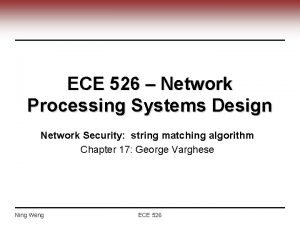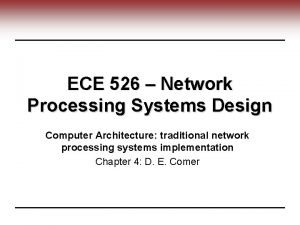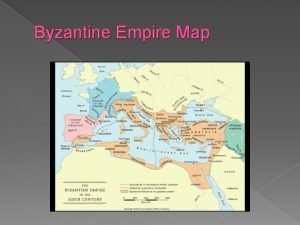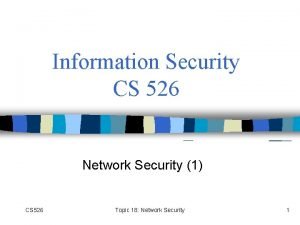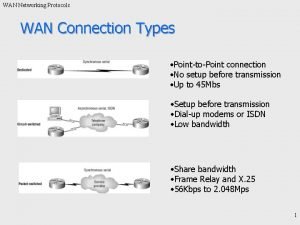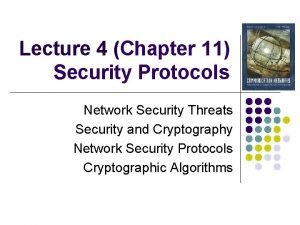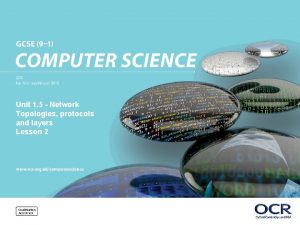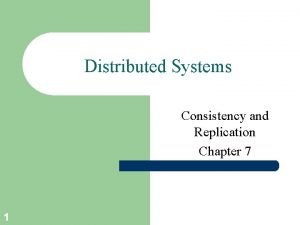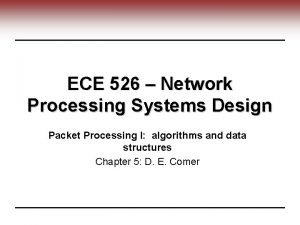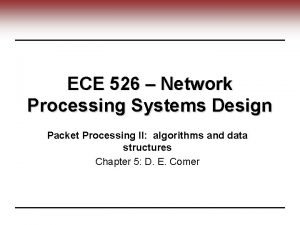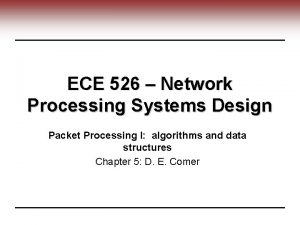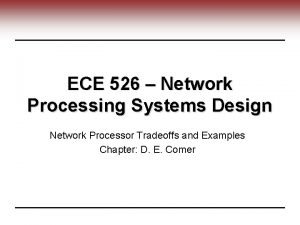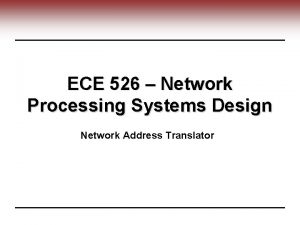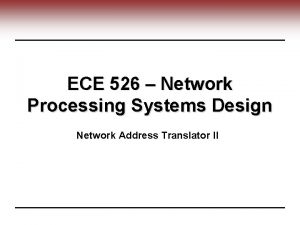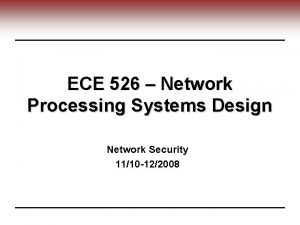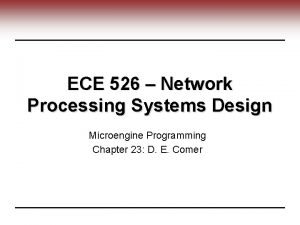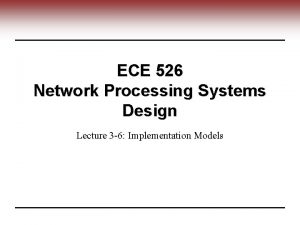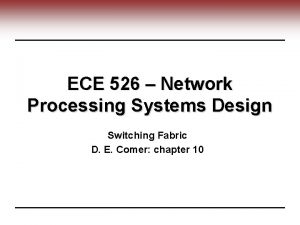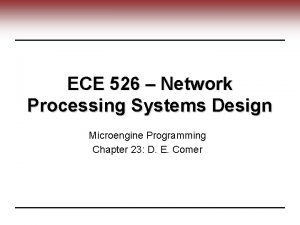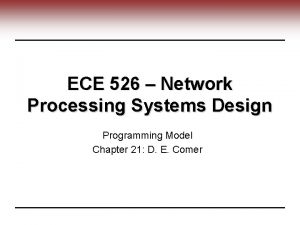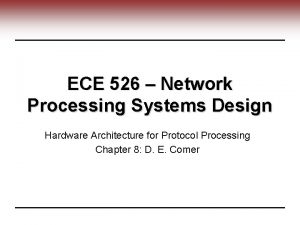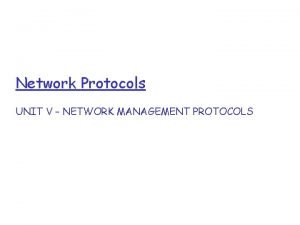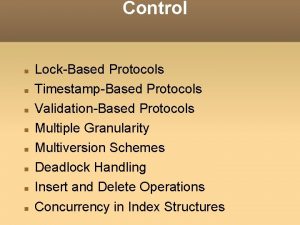ECE 526 Network Processing Systems Design Networking protocols























- Slides: 23

ECE 526 – Network Processing Systems Design Networking: protocols and packet format Chapter 3: D. E. Comer Fall 2008

Goals • Review important protocols and packet formats • Understand packet formats in different layers Ning Weng ECE 526 2

Outline • • Internet reference model Linker layer Network layer Transportation layer Ning Weng ECE 526 3

Internet Reference Model • Five layer Internet reference model • Multiple protocol can occur at each layer • Question: example protocols in each layer? Ning Weng ECE 526 4

Example Network Protocols • • Ning Weng Linker layer: Ethernet Network layer: IP Transport layer: TCP, UDP We are not interested in physical layer: CSMA … ECE 526 5

Data Link Layer • Providing communication between adjacent systems ─ Point-to-point or shared media communication ─ Specification of media access (e. g. , CSMA) • Three types of communication ─ Unicast: frame destined for single station ─ Multicast: frame destined for a subset of stations ─ Broadcast: frame destined for all stations in broadcast domain • Two protocols are important ─ Ethernet ─ ATM • We will concentrate on Ethernet Ning Weng ECE 526 6

Ethernet Frame Processing • Machine access control address (MAC) ─ ─ Hardware address 48 -bit Globally unique Not assigned to computer but Network Interface Card (NIC) • 16 -bit frame type: indicating the next layer protocol ─ 0800 (IP), 0806 (ARP) • Additionally: 64 -bit preamble, 32 -bit CRC trailer Ning Weng ECE 526 7

Network Layer: Internet Protocol • Internet Protocol (IP) functionality ─ Defines basic delivery service throughout the Internet ─ Provides end-to-end connectivity • Processing by IP routers • Internet packet header: Ning Weng ECE 526 8

IP Datagram Fields • Which field changed between hops? Ning Weng ECE 526 9

IP Addressing • 32 -bit Internet address assigned to each computer • Virtual, hardware independent value • Prefix identifies network; suffix identifies host ─ Hosts within a subnet have same address prefix ─ Example: ECE 131. 230. 194. *, SIUC 131. 230. * ─ Network address mask to specify boundary between prefix and suffix • Who assigns the prefix? ─ Internet Assigned Numbers Authority (IANA) sign it to Regional Internet Registries (RIR) • Are IP addresses globally unique? ─ No, network address translator allow private subnets ─ Private subnet address space: 192. 168. 0. 0/16, 172. 16. 0. 0/12 and 10. * Ning Weng ECE 526 10

Addressing Question • What is the difference between Ethernet and IP address? ─ Software (reconfigurable) vs. hardware (hard coded) ─ Globally unique or not ─ IP: prefix and suffix • Why need another address (IP), if Ethernet address is globally unique? ─ mobility moving the hosts or routers from one network to another ─ easiness to construct a subnet: prefix and suffix Ning Weng ECE 526 11

IP Forwarding • Routing Table ─ Found in both hosts and routers ─ Stores destination, mask, next hop • Example Routing Table network destination 131. 230. 0. 0 131. 230. 194. 0 Default netmask gateway/next hop 255. 0 131. 230. 193. 66 255. 0 131. 230. 194. 66 131. 230. 195. • Route lookup ─ Takes destination address as arguments ─ Finds next hop ─ Uses longest-prefix match Ning Weng ECE 526 12

IP Related Protocols • Several other protocols support IP: • We’ll cover routing tables with packet processing later Ning Weng ECE 526 13

Transport Layer • End-to-end protocols for communication between applications ─ Transport layer is not changed inside the network • How are applications identified? ─ Port number used for de-multiplexing • Two transport layer protocols ─ UDP (user datagram protocol) ─ TCP (transport control protocol) Ning Weng ECE 526 14

UDP Datagram Format Ning Weng ECE 526 15

Transport Control Protocol • UDP shortcomings ─ ─ Unreliable (packet loss) Packet reordering No congestion control No flow control • TCP addresses these problems ─ Acknowledgements and retransmission timers ─ Sequence numbers ─ Congestion and flow control windows Ning Weng ECE 526 16

TCP Header • Checksum, source and destination ports similar to UDP • Sequence and Acknowledgement is byte count (not packet) Ning Weng ECE 526 17

TCP Questions • How is a connection between two hosts established? ─ Three-way handshake • How is reliability ensured when packet is lost? ─ Packet is not acknowledged, timeout occurs, retransmission. • How is congestion control achieved? ─ Congestion window is continually increased to use available bandwidth ─ Congestion window is reduced when packet loss occurs Ning Weng ECE 526 18

Protocol Encapsulation • Protocols are encapsulated when sent out • Example Ning Weng ECE 526 19

Address Resolution Protocol • Used to map IP address of a computer to an Ethernet address • Used only within one network • ARP header Ning Weng ECE 526 20

Questions • Why not one protocol instead of many ones? ─ different applications need a different functionalities ─ different protocols solve different problems ─ easy to debug and design: concentrate one layer only ─ many protocols is connected by common protocol (IP) • Any cons for layered structure? Ning Weng ECE 526 21

Summary • Protocols standards ─ Defines semantics of computer communication ─ Specify packet formats ─ Addressing, forwarding • Internet protocols are divided into fiver conceptual layers ─ Layer 2: ethernet, ARP ─ Layer 3: IP ─ Layer 4: TCP, UDP Ning Weng ECE 526 22

For Next Class • Read Comer Chapter 4 ─ Computer Architecture: traditional network processing systems implementation Ning Weng ECE 526 23
 Ece 526
Ece 526 Ece 526
Ece 526 Ece 526
Ece 526 Sdn architecture vs traditional network
Sdn architecture vs traditional network Byzantine empire 526 ce
Byzantine empire 526 ce Silicone logo
Silicone logo Byzantine empire 526 ce
Byzantine empire 526 ce Rounding jeopardy
Rounding jeopardy Salmos 526
Salmos 526 Network security process
Network security process Types of wan
Types of wan Network security protocols
Network security protocols Playfair cipher
Playfair cipher Wireless sensor network protocols
Wireless sensor network protocols 5 network topologies
5 network topologies Network communication protocols map
Network communication protocols map Chapter 3 network protocols and communications
Chapter 3 network protocols and communications Consistency and replication in distributed systems
Consistency and replication in distributed systems Top-down processing vs bottom-up processing
Top-down processing vs bottom-up processing Gloria suarez
Gloria suarez Top-down processing vs bottom-up processing
Top-down processing vs bottom-up processing Neighborhood processing in digital image processing
Neighborhood processing in digital image processing Difference between primary and secondary processing
Difference between primary and secondary processing Define point processing
Define point processing
